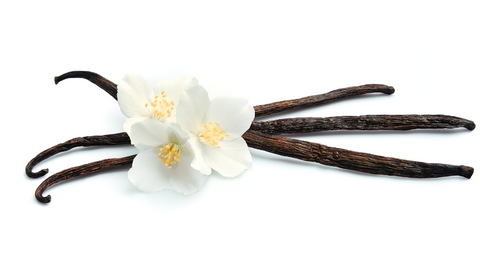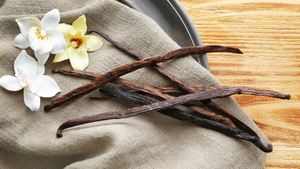Does "Natural" Vanilla Flavor Come From Beaver Butts?
The short answer, is no. But it's not really quite that simple. At one time, an alternative to vanilla was tied up with beavers, but as you can imagine that wasn't much more sustainable than using the vanilla bean itself. While the beaver gland was at least natural, the question remains- if you aren't selecting real vanilla bean flavored foods these days... what are you getting?
Beaver Butts
Last Christmas as I worked on various holiday treats, I found that I needed some vanilla cookies. I sent Carson to the store for them and he returned with an off-brand version because my approved brand was not in stock. My off-hand comment to the kids about my standards including only REAL vanilla included a mention of beaver butts… and set off a conversation around vanilla that is still going in my household today.

So let’s get this straight right off the bat. Yes- it is possible to isolate a substance from the anal glands of beavers. It’s called castoreum. Castoreum is prohibitively expensive to isolate, it turns out… and so, while it is possible that there was a time in your life that something you ate included “vanilla” made from beaver butt, it is not likely today. There are simply better, more efficient ways to get a synthetic vanilla… and some of them still allow the manufacturer to call it “natural” vanilla.
So, the cheap supermarket cookies probably don’t contain beaver butt, but they probably aren’t flavored with true vanilla either. This ancient, functional flavor is a great case study to discuss how good environmental intentions can lead to unintended negative outcomes…
Synthetic Flavor For Good?
A 2019 article in Forbes proudly proclaims that synthetic biology “doesn’t necessarily change the kind of things you buy, it’s just making them greener, better, and less expensive.”
The article on a new synthetic vanilla extolls the virtues of creating copies of natural substances because the strain on the natural world to produce and the cost of that production are simply too great. It’s an old argument (rationalization)… in the plant sciences. I heard it in undergrad classrooms as professors explained the need for us to interview traditional societies (shamanic practitioners) about the plants they use so we can send them off to a lab to be analyzed and mined for their chemicals components. We were told it was critical that we take these plants out of their cultural context because otherwise, the demand for the plant medicine we might discover could wipe out whole ecosystems and people groups.
This mentality has led to a more recent development anchored by a study released in 2021. Scientists have found a way to use genetically modified E. coli to digest plastic and after processing render vanillin as a product! I have so many concerns here I don’t really know where to start… but it looks as though this kind of synthetic vanilla is already in the food and beauty supply!
It is laudable to consider the environmental impact of any plant we’d like to use (see United Plant Savers for commendable work in this area), but it is a cop out to decide that we can’t find ways to enrich the people where the plant grows in a way that also protects the habitat.
How is “Natural” Vanilla Flavoring Different from Pure Vanilla?
While we are not under threat of consuming something from a beaver’s butt when eating something containing synthetic vanilla… a closer look might actually find it's even more disturbing.
Estimates place true vanilla pod production at only 1% of the world’s usage of vanilla flavor. That number is expected to drop, even while the potential for this plant as one of the top 2-3 cash crops on the planet is sky-rocketing. I can currently buy organic vanilla beans from India for about $10 per bean (5-7 beans in an ounce, costing $52). Curious, no?

Since the early 1900’s food manufacturers have been able to make use of synthetic alternatives (read cheap) to the artisanally produced true vanilla bean. These methods have largely employed the isolation of chemicals from other less valuable plants (clove, pine, rice) and manufacturing by-products (leftover wash from paper mills, plastic and coal tar).
We also have the ability to focus on the use of lignin in a similar way to how plastic is now being employed. Lignin is plant fiber, and it can be come by in a number of different ways. Most commonly manufacturing waste from another industry is used- this is more “green” and less wasteful… it is also cheaper. This is the first step toward vanilla and the goal is to metabolize ferulic acid.
How do we metabolize ferulic acid? Glad you asked! That is done by adding either Gram-positive bacteria or… using altered Escherichia coli… the feared bacteria often named as the responsible party for widespread food poisonings. E. coli is found in gut linings, fecal matter… and we’re back to butts (just not of the beaver)…
Once they have isolated ferulic acid, they can “naturally” ferment it and produce Vanillin, the active volatile compound that is responsible for the vanilla flavor and taste. The best part?
“Fermentation has the added advantage of producing pure, reliable ingredients. And because the fermented product is equivalent to what you get from nature, it can be labeled natural flavoring.”
How Rare is Real Vanilla?
Why do we need to go to these lengths- including altering a bacteria that is supposedly so scary that we shouldn’t eat any real food to avoid it – to mimic something that humans have been cultivating since at least the time of the pre-Aztec Totonac people of central Mexico?
I have a few theories… how about you?
This is a different route than was taken with sassafrass, but no less effective. Here, there aren’t any studies that could be used to suggest that natural vanilla isn’t safe. So the way to lead a hungry public away from a natural solution in favor of a solution that can be patented and reproduced cheaply in large quantities is to lean into the “green” fear.
Vanilla, it is said, is getting harder to grow because of climate changes. It is too expensive. It is too labor intensive (a great opportunity to add concerns of worker exploitation). It has a large carbon footprint because it must be shipped from tropical places. So, it is logical that we simply have to create a different way to get our vanilla fix.
The truth is… let’s say, somewhere in the middle. Yes, it is expensive and it grows only in tropical places. Wild vanilla is critically endangered, but it continues to be grown in plantation. The process from harvest to store is quite extensive and requires a skill set that, like many other examples of traditional knowledge, is itself under threat of extinction.


1 comment
Thanks so much for the information,it was very enlightening. Please send me a link as to where I too may buy pure vanilla bean as you do. Or information on where you buy yours. Have a beautiful day. I really like your philosophy about about your food for family and your consumers. 🌞🌻